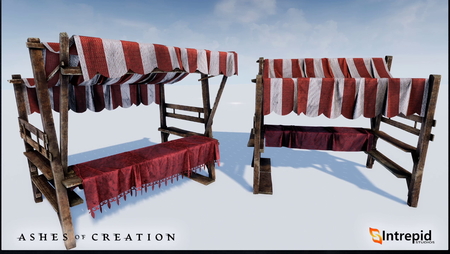NPCs
NPCs react differently to players based on their contributions to a node.[1]
Node development
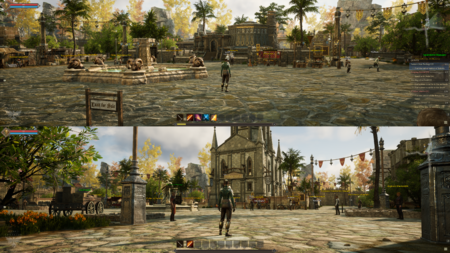
The layout and architecture within a Node’s development area are determined by influential race. For example, a stage 3 Node with the majority of player contribution being Py'rai would have a Py'rai village with Py'rai architecture. Most NPCs would be Py'rai elves, and offer questlines within the Py'rai narrative.[2] – Margaret Krohn
Each player’s contributed experience is flagged with their character race and other identifiers. When a Node advances, the race with the highest experience contribution determines the Node’s style and culture. This style and culture change can happen at every Node Stage. For example, if a Node advances to Level 2 - Encampment Stage and 51% of all experience was earned by Ren’Kai players, the Node will be a Level 2 Ren’Kai Node. If that same Node advances to a Level 3 - Village Stage Node, but the Py'Rai contributed 62% of all the experience earned, then the Node will be a Level 3 Py'Rai Node.[3] – Margaret Krohn
Node layout and style is determined by several factors:[4][5]
- The way that the node system is built is that they can exist across a spread of 18 biomes, but at the same time have to represent the cultural influence of these cultures that are intrinsically a part of a specific biome.[6] – Steven Sharif
- Environment (biome) and location of the node.[6][4][5]
- Nodes will adjust the local topography to fit the aesthetic and mechanical requirements of the node.[7]
- Currently the way that the platform system is set up, is it's capable of adjusting the topography of the node's footprint, regardless of the surrounding terrain. So the reason for that is we want to have flexibility in the presentation of the node's layout and how it is essentially both from an aesthetic standpoint as well as a mechanical standpoint with node sieges- how it's constructed and that construction should have the ability to take on a variance of different types of topography. So it shouldn't be dependent on the surrounding area. Now that's not to say that the surrounding area isn't going to have some influence over. So for example... we're experimenting a little bit with the platform tech and putting up a node up against the side of a mountain or on the edge of a cliff or something that has a beautiful vista. Those are things that we're going to test out obviously as we continue to work on the node tool and how that platform system works, but the idea is to have the node independent of the surrounding terrain.[7] – Steven Sharif
- Some parts are determined by the area it's in. Some parts are determined by the type it is. Some parts are determined by the race it is; and then the rest of it is determined by the mayor.[5] – Jeffrey Bard
- Race that contributed the highest percentage to the node's advancement will alter the racial appearance of its buildings, NPCs, and props.[8][9][4][3][5][10][11]
- All nodes, whether they're associated with a castle or associated with normal node structure, has cultural influences that replicate over to the buildings that are produced and the NPCs that are present.[13] – Steven Sharif
- The rest is determined by the node's mayor.[5]
- It should be possible for a node to complete several building projects within a mayor's one month term in office.[14]
- Q: How long would you say it will take players on average to fill/build up a node completely from wilderness to metropolis?
- A: It's one thing to get a node to a certain level: it's another thing to develop the node; and I can't really give you an on-average expectation, because there's a lot of variables at play. There's how many citizens does the node have attracted to it; what's the type of traffic that the node is attracting to it based on things like its tax rates, or the specialization that it chose to spec into, based on the building types it's chosen to build. All of those things are variables that can affect the quote-unquote "average build-out time" of a particular node. So it's difficult to give you an average when there's so many variables along those lines. But the idea is that if there is a particular project that players are interested in in developing based on the node stage, that they would have the ability to complete several of those projects as within a single term of a mayor; and a term of a mayor is one month.[14] – Steven Sharif
Player stalls
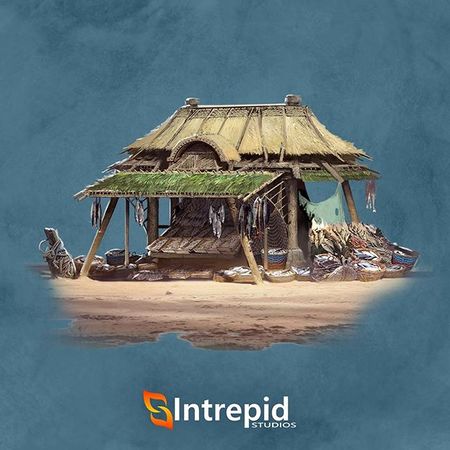
If there were ever a cornerstone serving as the bedrock of Niküan trade, then this modest stall would be it. Stacked from floor to thatched roof with all manner of catch, it is prepped for a full day of commerce and trade. Here, haggling is not merely a suggestion, but a requirement.[15]
Player stalls (also called Kiosks and rental stalls) are rentable locations near the unique building in an Economic node[17], in Marketplaces (the constructible building available for placement by mayors of any Town (stage 4) node or higher), or as business buildings on freehold plots.[18][19]
- All nodes do have the ability to spawn player stalls. If you're not an economic node and you don't have a market- that's essentially your unique building- then you can construct essentially what is I guess would be called a... marketplace; and that marketplace will then come with certain services and it will come with a certain number of stalls. The economic node as I recall has the ability to construct an auction house and the auction house serves through the economic means the ability to list and sell items and that comes with additional stalls as well for the players.[19] – Steven Sharif
Renting a player stall enables players to sell items as well as provide repair and enchanting services, even when they are not online.[20]
- Player stalls are rentable by node citizens.[21]
- Player stalls may be utilized for a period of time based on the price paid to rent the stall.[20]
- Player stalls are linked to a player's warehouse.[22]
- Player stalls do not require the attendance of the character or for that character to be online.[21]
- Players are able to input required items for repair and also purchase required materials for that repair.[24]
- Player stalls may still operate during node siege declaration. This is subject to testing.[25]
- Players are not able to be attacked or robbed while occupying their player stall inside the limits of a node.[26]
- Bulletin boards that list the items available in player stalls can be accessed from anywhere in the region.[23]
- These give the location of the stall so players can travel there and purchase the items.[23]
- Stall sales are also listed in auction houses.[27]
- This may no longer be accurate.[28]
Siege mechanics
A siege occurs over several phases.[29]
- Certain siege mechanics may be gated for specific size groups during sieges.[30]
- There will not be a deserter debuff for leaving a siege before it is complete.[31]
- More will be revealed in an upcoming blog entry.[29]
Farmhands and NPC assistance
Based on node type and progression, players will be able to hire NPCs to work as farmhands on their freehold farms.[32] Players will be able to command these farmhands in-game as well as potentially offline via an application (mobile app) or web interface.[32][33][34]
Day/night cycle
Transportation of goods
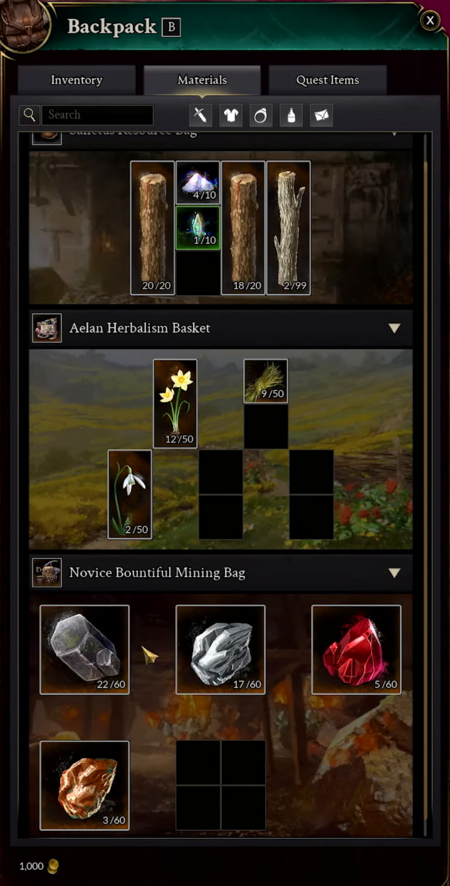
Inventory for A2 will exist in two categories, spatial and non-spatial. The spatial inventory system will only exist for materials and gatherables. The non-spatial system will be the normal single slot inventory that is used for all completed items IE gear, consumables etc.. The spatial system is intended to provide limitation and progression when everything in the open world is gatherable, requiring players to strategize which things they choose to gather or not. These spatial inventories will be shaped in various ways that make the bag types more conducive for certain types of gatherables allowing players to specialize their capacity. Auto sort is a feature[36] – Steven Sharif
Inventory capacity has quantity (stacking) limits based on the type of item.[37][38] Backpacks offer varying stack sizes and/or spatial inventory shapes that are optimized for carrying different items.[39][40]
- A player's inventory has sections for different types of items.[41] Quest items for example will not fill a player's regular inventory capacity.[42]
- Materials and resource bags have spatial ("Tetris" style) slots for items with different shapes and sizes.[43][36][44][45][46]
- The spatial inventory system is intended to mitigate the potential for players to diminish land management scores by stripping resources from particular zones as well as provide a challenging gameplay layer for players.[43][47]
- Inventory is split into two separate management systems. The first is your non-material, non-gatherable slots. Those are your standard single slot, not-space-constrained system that's a standard inventory: you just have a single slot, and you can pull completed items and/or consumables and quest items or whatever into that slot. And then, when you're talking about materials, specifically processed goods and gatherables: those exist within the Tetris type uh inventory system.[44] – Steven Sharif
- All those materials actually sorted nicely in the appropriate bags based on your stack sizes.[35] – Alex Khudoliy
- There will be a healthy number of slots for gear in a player's inventory.[48]
- Completed item inventory slots are not space constrained (by the tetris system).[44]
- Completed items, such as gear are also not subject to weight limits.[48]
- Gear loadouts can be swapped using a hotkey when out of combat.[48][49][50]
- Inventory capacity will be relatively limited for new characters.[42] Additional capacity may be increased by obtaining higher quality backpacks from crafters.[51][44][37]
- We want to have very unique progression when it comes to the construction of resource bags; and those resource bags will have certain benefits, like increasing stack size count of particular types of resources; or of having a additional delay time necessary to interface with with your corpse, should a player try to take the resources you might have dropped in PvP; or having passive benefits and unique structures of spacing that makes it more a better bag for wood gathering because woods are three-by-one; or a better bag for mining because mining is always two-by-two. The idea is to make your intent as a gatherer when you go out into the wild specific right not just that you're going out into the wild and gathering everything you can because it's there; and that's what we don't have like a labor system that limits it. We have a space constraint system so when you leave your node and you go out into the wild you need to be conscientious of what you're choosing to interact with and take resources for, because you have a limited space constraint to that degree.[44] – Steven Sharif
- Inventory capacity is subject to quantity rather than weight limits.[37]
- In my opinion, and this is of course subjective, but weight management is not a compelling mechanic for players to have to deal with in an MMO setting.[37] – Steven Sharif
- Players will have the ability to search for items they have stored in various locations (such as personal storage and node warehouses).[52]
- We want you to know where the things are; and then the meaningful aspect of that thing is traveling to those locations to access some of those things, particularly as it relates to materials and raw gatherables.[52] – Steven Sharif
- Inventories will be able to be sorted.[36]
- Q: Why did you go for a spatial inventory system for resources?
- A: There's a number of different methods that we can use in an effort to mitigate, or again throttle, the amount of success that players can have in any one trip out in the world. Now, we're using a combination of three things: We are using progression gating through your profession level; so you need to have a certain level to access certain resources. We are utilizing the spatial inventory space as a limitation on how much things you can gather before you need to go back to town. And then lastly we have a tool predicate where you need to have a tool that is relevant for the resource you're gathering; and those tools have a decay value after each use. Weight is obviously an approach that we could take if we wanted to limit. However, the spatial system works in concert with a number of other types of systems. For example, we want to have itemization drop on death specifically as it relates to material items; and we want there to be an additional layer above just weight that introduces complexity; and where there is complexity there is choice and there is strategy and there is planning required on behalf of the player in order to set themselves up for the best possible success in certain situations.[43] – Steven Sharif
- Mules can carry roughly 10 times more than backpacks. Caravans can carry roughly 10 times more than mules.[53]
- Inventory expansion and weight management training certificates are available in the Galleria at City stage economic nodes.[42][54]
See also
References
- ↑
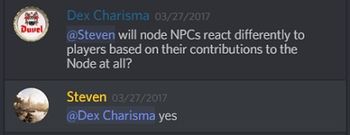
- ↑ Blog - Know Your Nodes - The Basics.
- ↑ 3.0 3.1 3.2 Blog - Know Your Nodes - Advance and Destroy.
- ↑ 4.0 4.1 4.2 Livestream, October 30, 2020 (39:17).
- ↑ 5.0 5.1 5.2 5.3 5.4 5.5 Livestream, September 27, 2018 (53:06).
- ↑ 6.0 6.1 Livestream, February 25, 2022 (41:00).
- ↑ 7.0 7.1 Livestream, February 26, 2021 (1:12:18).
- ↑ Livestream, March 31, 2022 (4:57).
- ↑ Podcast, April 11, 2021 (29:47).
- ↑ Interview, May 11, 2018 (54:34).
- ↑ Livestream, May 26, 2017 (21:23).
- ↑ Podcast, April 11, 2021 (23:36).
- ↑ 13.0 13.1 Interview, May 11, 2018 (47:27).
- ↑ 14.0 14.1 Livestream, July 29, 2022 (1:13:09).
- ↑ 15.0 15.1 Ashes of Creation Instagram, 2020-08-19.
- ↑ Livestream, May 29, 2020 (1:00:57).
- ↑ Livestream, May 30, 2019 (1:26:16).
- ↑ Livestream, June 30, 2023 (25:05).
- ↑ 19.0 19.1 Interview, July 8, 2020 (55:05).
- ↑ 20.0 20.1 20.2 Livestream, May 10, 2017 (16:36).
- ↑ 21.0 21.1

- ↑ 22.0 22.1 Livestream, October 30, 2020 (1:04:59).
- ↑ 23.0 23.1 23.2 Livestream, May 10, 2017 (35:16).
- ↑

- ↑ Livestream, October 30, 2020 (1:06:09).
- ↑ Livestream, October 16, 2017 (59:39).
- ↑

- ↑ Livestream, July 31, 2020 (1:34:06).
- ↑ 29.0 29.1

- ↑

- ↑ Livestream, May 24, 2017 (37:05).
- ↑ 32.0 32.1 32.2 32.3 Interview, July 9, 2023 (1:37:34).
- ↑ 33.0 33.1 33.2 Livestream, May 9, 2017 (28:57).
- ↑ 34.0 34.1 34.2 Livestream, November 17, 2017 (11:00).
- ↑ 35.0 35.1 35.2 Video, November 30, 2023 (30:19).
- ↑ 36.0 36.1 36.2 Twitter - Steven Sharif - Spatial inventory slots.
- ↑ 37.0 37.1 37.2 37.3 Livestream, February 24, 2023 (54:55).
- ↑ Livestream, May 29, 2020 (1:27:18).
- ↑ Video, November 30, 2023 (13:38).
- ↑

- ↑ Livestream, February 24, 2023 (22:57).
- ↑ 42.0 42.1 42.2 Livestream, July 25, 2020 (1:14:13).
- ↑ 43.0 43.1 43.2 Livestream, November 30, 2023 (1:29:18).
- ↑ 44.0 44.1 44.2 44.3 44.4 Livestream, June 30, 2023 (1:24:42).
- ↑ Livestream, June 30, 2023 (46:17).
- ↑ Video, June 30, 2023 (8:54).
- ↑ Podcast, July 15, 2023 (22:57).
- ↑ 48.0 48.1 48.2 Interview, September 10, 2023 (47:13).
- ↑ Livestream, February 24, 2023 (46:15).
- ↑ Livestream, November 19, 2021 (40:53).
- ↑ Livestream, November 30, 2023 (1:34:08).
- ↑ 52.0 52.1 Livestream, July 29, 2022 (1:17:33).
- ↑ Livestream, July 18, 2017 (44:57).
- ↑ Know Your Nodes: Economic Node Type.
